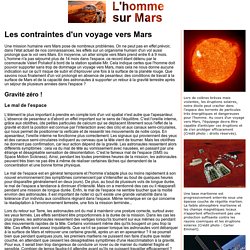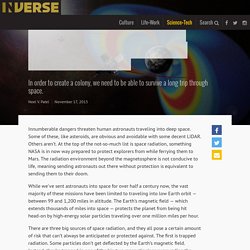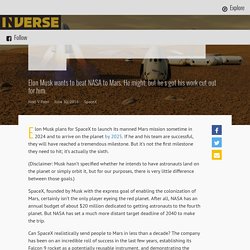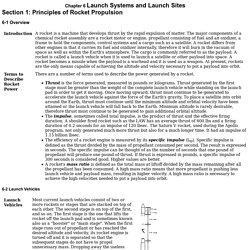

L'homme sur Mars : Les contraintes d'un voyage vers Mars. Une mission humaine vers Mars pose de nombreux problèmes.

On ne peut pas en effet prévoir, dans l'état actuel de nos connaissances, les effets sur un organisme humain d'un vol aussi prolongé que le vol vers Mars. En moyenne, un aller simple vers Mars prend entre 6 à 9 mois. L'homme n'a pas séjourné plus de 14 mois dans l'espace, ce record étant détenu par le cosmonaute Valeri Poliakof à bord de la station spatiale Mir.
Cela indique certes que l'homme doit pouvoir supporter sans trop de dommage un voyage vers Mars, mais cela ne nous donne aucune indication sur ce qu'il risque de subir et d'éprouver une fois à la surface de la planète rouge. Generation Mars, Part 2 - Home. The day might well be approaching when humans set foot on Mars.

We'll be driven by a desire to find life -- or what remains of it -- and to colonize the planet. Stephen Humphrey and a stellar crew of authors, astronauts and Mars scholars confront the hazards, risks and challenges of getting humans to Mars, and then of surviving -- and living -- on the Red Planet. Young Stephen Humphrey. Colonizing Mars. Elon Musk debuting the ITS plans A Critique of the SpaceX Interplanetary Transport System Robert Zubrin In remarks at the International Astronautical Congress in Guadalajara, Mexico on September 29, 2016, SpaceX founder and CEO Elon Musk revealed to great fanfare his company’s plans for an Interplanetary Transport System (ITS).

According to Musk, the ITS would enable the colonization of Mars by the rapid delivery of a million people in groups of a hundred passengers per flight, as well as large-scale human exploration missions to other bodies, such as Jupiter’s moon Europa. I was among the thousands of people in the room (and many more watching live online) when Musk gave his remarkable presentation, and was struck by its many good and powerful ideas. Design of the SpaceX Interplanetary Transport System. Space Radiation Is Quietly Stopping Us From Sending Humans to Mars. Innumberable dangers threaten human astronauts traveling into deep space.

Some of these, like asteroids, are obvious and avoidable with some decent LIDAR. Others aren’t. At the top of the not-so-much list is space radiation, something NASA is in now way prepared to protect explorers from while ferrying them to Mars. The radiation environment beyond the magnetosphere is not conducive to life, meaning sending astronauts out there without protection is equivalent to sending them to their doom. While we’ve sent astronauts into space for over half a century now, the vast majority of these missions have been limited to traveling into low Earth orbit — between 99 and 1,200 miles in altitude.
There are three big sources of space radiation, and they all pose a certain amount of risk that can’t always be anticipated or protected against. Artist's depiction of solar wind particles interacting with Earth's magnetosphere For NASA, acceptable risk means a three percent excess lifetime risk of cancer. SpaceX's Pre-Mars Mission Checklist. Elon Musk plans for SpaceX to launch its manned Mars mission sometime in 2024 and to arrive on the planet by 2025.

If he and his team are successful, they will have reached a tremendous milestone. But it’s not the first milestone they need to hit; it’s actually the sixth. (Disclaimer: Musk hasn’t specified whether he intends to have astronauts land on the planet or simply orbit it, but for our purposes, there is very little difference between those goals.) SpaceX, founded by Musk with the express goal of enabling the colonization of Mars, certainly isn’t the only player eyeing the red planet. After all, NASA has an annual budget of about $20 million dedicated to getting astronauts to the fourth planet. Expédition sur Mars. Magnetoplasma Rocket. PRINCIPLES OF ROCKET PROPULSION. Chapter 6Launch Systems and Launch Sites Section 1: Principles of Rocket Propulsion.

About the company - XCOR - Life-changing. WHY DO WE EXIST?

These days, space is no longer the exclusive domain of governments and institutions like NASA and ESA. Space offers boundless technology and business opportunities. To open the market for commercial space, frequency must increase, costs should drop and capabilities should dramatically improve. Tucson space tourism company nearer to manned flight. Commercial space tourism is one step closer to being a reality.

Last month, World View Enterprises Inc., a Tucson-based commercial balloon spaceflight company, successfully flew the first parafoil, a wing-like parachute, from the edge of space. Though the company has flown a high-altitude balloon at that height before, this is the first time a parafoil has been flown at 102,200 feet, which is roughly the altitude it hopes to fly passengers. Instead of being propelled by a rocket, World View’s vessel is attached to a lighter-than-air helium-filled balloon that lifts it off the ground. The gentle ascent 20 miles above Earth takes one to two hours as the balloon expands and decreases in density.
The craft will hover at the target altitude in the stratosphere for around two hours, and the goal is to give six passengers — who will pay $75,000 for a seat — time to admire the view, and researchers time to conduct experiments. Histoire du vol spatial. L'histoire du vol spatial retrace au cours du temps l'exploration de l'univers et des objets célestes du Système solaire par l'envoi soit d'engins robotisés (satellites, sondes et robots), soit de vaisseaux pilotés par des équipages humains.

Sa conquête a inspiré de nombreux écrivains et philosophes. Uk.businessinsider. How (and Why) SpaceX Will Colonize Mars.